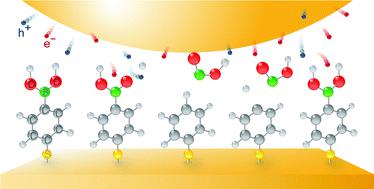Our official English website, www.x-mol.net, welcomes your
feedback! (Note: you will need to create a separate account there.)
Plasmon-driven protodeboronation reactions in nanogaps
Nanoscale ( IF 5.8 ) Pub Date : 2020-11-24 , DOI: 10.1039/d0nr07023h Ly Thi Minh Huynh 1, 2, 3, 4 , Hoa Duc Trinh 1, 2, 3, 4 , Sungwoon Lee 1, 2, 3, 4 , Sangwoon Yoon 1, 2, 3, 4
Nanoscale ( IF 5.8 ) Pub Date : 2020-11-24 , DOI: 10.1039/d0nr07023h Ly Thi Minh Huynh 1, 2, 3, 4 , Hoa Duc Trinh 1, 2, 3, 4 , Sungwoon Lee 1, 2, 3, 4 , Sangwoon Yoon 1, 2, 3, 4
Affiliation

|
Boronic acids are the key compounds in Suzuki coupling reactions and in the detection of monosaccharides. The C–B bond cleavage deboronation is an important side reaction that lowers the Suzuki coupling reaction yield and even disables saccharide detection. Here, we report that protodeboronation occurs for 4-mercaptophenylboronic acid (MPBA) within narrow nanogaps between gold nanoparticles (AuNPs) and planar gold substrates. The irradiation of such nanoparticle-on-mirror (NPoM) systems at 785 nm drives the protodeboronation reaction to form benzenethiol (BT). Wavelength-dependence experiments, combined with dark-field single-particle scattering spectroscopy, reveal that excitation of the bonding dipole plasmon mode of the NPoM leads to the best efficiency. Among the excited plasmon decay pathways, the generation of hot charge carriers induces the protodeboronation of MPBA. The possibility of plasmonic thermal reactions is ruled out because external heating of the substrates does not cause the reaction to take place. A comparison of the reaction yield under ambient, Ar, and oxygen gas conditions reveals that hot charge carriers directly transfer to MPBA, which subsequently produces BT, but the presence of oxygen promotes the reaction by opening another hot-electron transfer channel. The protodeboronation reaction of MPBA is an important addition to the catalog of plasmon-driven chemical reactions, not only because the reaction is relevant to organic and analytical chemistry but also because it deepens our understanding of the hot carrier dynamics at the interface between plasmonic nanoparticles and molecules.
中文翻译:

纳米间隙中等离子驱动的原脱硼反应
硼酸是铃木偶联反应和单糖检测中的关键化合物。C–B键断裂的脱硼作用是重要的副反应,它会降低Suzuki偶联反应的收率,甚至使糖类检测失效。在这里,我们报告原脱硼发生在金纳米颗粒(AuNPs)和平面金基质之间的狭窄纳米间隙内的4-巯基苯基硼酸(MPBA)。此类纳米镜上纳米粒子(NPoM)系统在785 nm处的辐照驱动原脱硼硼烷反应形成苯硫醇(BT)。波长依赖性实验与暗场单粒子散射光谱法相结合,揭示了NPoM的键合偶极等离子体激元模式的激发导致最佳效率。在激发的等离激元衰变途径中,热载流子的产生诱导了MPBA的原脱硼。排除了等离子体热反应的可能性,因为基材的外部加热不会引起反应发生。在环境,氩气和氧气条件下反应产率的比较表明,热电荷载流子直接转移到MPBA,随后产生BT,但是氧的存在通过打开另一个热电子转移通道促进了反应。MPBA的原去硼氢反应是等离激元驱动的化学反应目录的重要补充,不仅因为该反应与有机化学和分析化学有关,而且因为它加深了我们对等离激元纳米颗粒与等离子之间界面热载流子动力学的理解。分子。排除了等离子体热反应的可能性,因为基材的外部加热不会引起反应发生。在环境,氩气和氧气条件下反应产率的比较表明,热电荷载流子直接转移到MPBA,随后产生BT,但是氧的存在通过打开另一个热电子转移通道促进了反应。MPBA的原去硼氢反应是等离激元驱动的化学反应目录的重要补充,不仅因为该反应与有机化学和分析化学有关,而且因为它加深了我们对等离激元纳米颗粒与等离子之间界面热载流子动力学的理解。分子。排除了等离子体热反应的可能性,因为基材的外部加热不会引起反应发生。在环境,氩气和氧气条件下反应产率的比较表明,热电荷载流子直接转移到MPBA,随后产生BT,但是氧的存在通过打开另一个热电子转移通道促进了反应。MPBA的原去硼氢反应是等离激元驱动的化学反应目录的重要补充,不仅因为该反应与有机化学和分析化学有关,而且因为它加深了我们对等离激元纳米颗粒与等离子之间界面热载流子动力学的理解。分子。
更新日期:2020-11-27
中文翻译:

纳米间隙中等离子驱动的原脱硼反应
硼酸是铃木偶联反应和单糖检测中的关键化合物。C–B键断裂的脱硼作用是重要的副反应,它会降低Suzuki偶联反应的收率,甚至使糖类检测失效。在这里,我们报告原脱硼发生在金纳米颗粒(AuNPs)和平面金基质之间的狭窄纳米间隙内的4-巯基苯基硼酸(MPBA)。此类纳米镜上纳米粒子(NPoM)系统在785 nm处的辐照驱动原脱硼硼烷反应形成苯硫醇(BT)。波长依赖性实验与暗场单粒子散射光谱法相结合,揭示了NPoM的键合偶极等离子体激元模式的激发导致最佳效率。在激发的等离激元衰变途径中,热载流子的产生诱导了MPBA的原脱硼。排除了等离子体热反应的可能性,因为基材的外部加热不会引起反应发生。在环境,氩气和氧气条件下反应产率的比较表明,热电荷载流子直接转移到MPBA,随后产生BT,但是氧的存在通过打开另一个热电子转移通道促进了反应。MPBA的原去硼氢反应是等离激元驱动的化学反应目录的重要补充,不仅因为该反应与有机化学和分析化学有关,而且因为它加深了我们对等离激元纳米颗粒与等离子之间界面热载流子动力学的理解。分子。排除了等离子体热反应的可能性,因为基材的外部加热不会引起反应发生。在环境,氩气和氧气条件下反应产率的比较表明,热电荷载流子直接转移到MPBA,随后产生BT,但是氧的存在通过打开另一个热电子转移通道促进了反应。MPBA的原去硼氢反应是等离激元驱动的化学反应目录的重要补充,不仅因为该反应与有机化学和分析化学有关,而且因为它加深了我们对等离激元纳米颗粒与等离子之间界面热载流子动力学的理解。分子。排除了等离子体热反应的可能性,因为基材的外部加热不会引起反应发生。在环境,氩气和氧气条件下反应产率的比较表明,热电荷载流子直接转移到MPBA,随后产生BT,但是氧的存在通过打开另一个热电子转移通道促进了反应。MPBA的原去硼氢反应是等离激元驱动的化学反应目录的重要补充,不仅因为该反应与有机化学和分析化学有关,而且因为它加深了我们对等离激元纳米颗粒与等离子之间界面热载流子动力学的理解。分子。











































 京公网安备 11010802027423号
京公网安备 11010802027423号